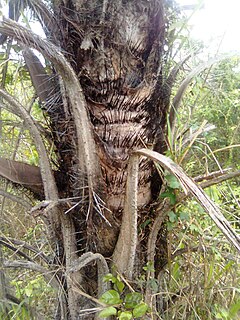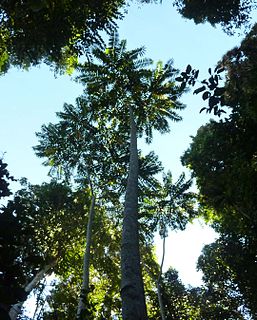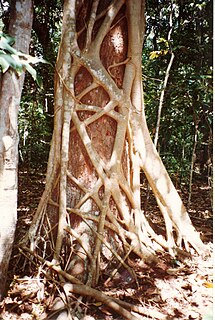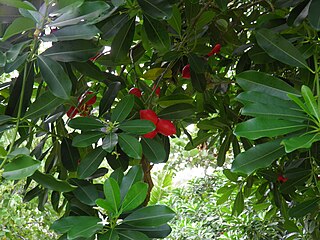 W
WAnnona purpurea is an edible fruit and medicinal plant in the Annonaceae family. It is native to Mexico, Central America, and parts of South America. Its common names include soncoya, sincuya, and cabeza de negro.
 W
WAntidesma bunius is a species of fruit tree in the family Phyllanthaceae. It is native to Southeast Asia and northern Australia. Its common Philippine name and other names include bignay, bugnay or bignai, Chinese-laurel, Queensland-cherry, salamander-tree, wild cherry, and currant tree. This is a variable plant which may be short and shrubby or tall and erect, approaching 30 metres in height. It has large oval shaped leathery evergreen leaves up to about 20 cm long and seven wide. They are attached to the twigs of the tree with short petioles, creating a dense canopy.
 W
WAstrocaryum jauari is the most frequently encountered palm native to Amazon Rainforest vegetation in the floodplains of the Rio Negro, in Brazil. Its fruits are edible. This plant has further commercial value because it may be used in the production of heart of palm.
 W
WBaccaurea macrocarpa, also called tampoi, is a small, tropical rainforest substorey fruit trees native to Southeast Asia, especially Borneo. It is dioecious, and the female trees bear fruit directly on the trunk and large branches. The fruit is large, orange-skinned, white-fleshed, with a delicious tangy flavour somewhat like mandarin (tangerine). Depending on conditions, the fruit may closely clothe the trunk beautifully, like the fruit of many Ficus species.
 W
WBallyfatten, also, Bally Fatten is a cultivar of domesticated apple.
 W
WThe Bloody Ploughman is a domesticated apple cultivar. The cultivar originated in Scotland.
 W
WCorylus yunnanensis, the Yunnan hazel, is a species of hazelnut found in western China. It is a small tree or shrub. The flowers have triangular shaped petals. The round nuts which are encased in a very tough oval shaped shell and can be consumed by humans. The plant is not commercially grown for the nuts, rather they are sometimes used as ornamental plants. They are located in Western Guizhou, Hubei, South Western and Western Sichuan, and Western Yunnan.
 W
WCrataegus aestivalis, known as the eastern mayhaw, is a shrub or small tree of the southeastern United States that grows in low-lying or wet areas from eastern Alabama to central Florida and Virginia. It is one of several species of hawthorn with fruits known as "mayhaws", which are harvested for use in making mayhaw jelly, considered a delicacy in many areas of the South. Other species of mayhaws include Crataegus opaca, the western May Hawthorn, which is native from east Texas to Alabama.
 W
WCrataegus phaenopyrum is a species of hawthorn commonly known as Washington hawthorn or Washington thorn. It is widely grown as an ornamental plant, and can reach 10 m in height. The small red berry-like fruit grow closely together in large clusters and are food for squirrels and birds. They have a mild flavor and can be eaten raw or cooked. As with other species of hawthorn, the wood is hard and can be used to make tools.
 W
WCrataegus sanguinea is a species of hawthorn that is native to southern Siberia, Mongolia, and the extreme north of China. It is cultivated for its edible red berry-like fruit which actually is a pome. The fruit can be eaten raw or cooked. They can be used to make jam, jelly, and fruit preserves. They are also grown in gardens as ornamental plants. The flowers are small, white in color, and occur in clusters. The flowers give off a carrion smell.
 W
WCrescentia is a genus of six species of flowering plants in the family Bignoniaceae, native to southern North America, the Caribbean, Central America northern South America, West Africa and South Africa. The species are moderate-size trees growing to 10 m (35 ft) tall, and producing large spherical fruits, with a thin, hard shell and soft pulp, up to 25 cm (10 in) in diameter.
 W
WCrescentia cujete, commonly known as the calabash tree, is a species of flowering plant that is grown in Africa, Central America, South America, the West Indies and extreme southern Florida. It is the national tree of St. Lucia. It is a dicotyledonous plant with simple leaves, which are alternate or in fascicles (clusters) on short shoots. It is naturalized in India.
 W
WDavidsonia johnsonii, commonly known as smooth Davidson's plum, is a small tree native to rainforests of eastern Australia. The leaves are compound, glossy and hairless. It is a very rare tree in the wild, but is cultivated for its edible fruit.
 W
WDetarium is a plant genus of the family Fabaceae. It contains 3 species of tree in west African forests.
 W
WDurio dulcis, known as durian marangang, red durian, tutong, or lahong, is a fairly large tree in the genus Durio. It can grow up to 40 m tall. The husk of its fruit is dark red to brown-red, and covered with slender 15–20 mm long spines. The fruit flesh is dark yellow, thin, and deep caramel-flavored, with a turpentine odor. The fruit of this species is considered by many to be the sweetest of all durians.
 W
WDurio kutejensis, commonly known as durian pulu, durian merah, nyekak, Pakan, Kuluk, or lai, is a primary rainforest substorey fruit tree from Borneo. It is a very attractive small- to medium-sized tree up to 30 m tall. It has large, glossy leaves, numerous large, red flowers that emit a strong carrion smell at anthesis. This species is reportedly pollinated by giant honey bees and birds, as well as bats. The large durian fruit it bears has thick, yellow flesh with a mild, sweet taste and creamy texture similar to that of Durio zibethinus. It bears fruit late in the season. It is cultivated in East Kalimantan and has been introduced to Queensland. In Brunei, the fruit of D. kutejensis is preferred by local consumers over that of D. zibethinus, though the latter is the only durian species available in the international market. The fruit is also said to have fewer of the unpleasant flavors that D. zibethinus has.
 W
WDysoxylum gaudichaudianum is a species of plant in the family Meliaceae; its common name is ivory mahogany. "Igyo" is its native name in the Philippines.
 W
WEriobotrya is a genus of flowering plants, mostly large evergreen shrubs and small trees in the family Rosaceae, native to woodland in the Himalayas and East Asia. The loquat, E. japonica, is grown for its edible fruit.
 W
WEugenia luschnathiana is a flowering plant in the family Myrtaceae, native to the state of Bahia, Brazil. The fruit is known as pitomba-da-bahia, and is also called uvalha do campo, ubaid do campo or uvalheira in Brazil. It shares the name pitomba with another South American species, Talisia esculenta.
 W
WEugenia punicifolia is a species of plant in the family Myrtaceae. It is found in Bolivia and Brazil.
 W
WEugenia victoriana is a small South American fruit tree of the genus Eugenia. Its common names include guayabilla and sundrop.
 W
WThe Drooping fig is a small to medium-sized fodder tree of genus Ficus. It bears edible fruit. The figs on the lower part of the leafless branches may develop in leaf litter and humus, and be buried in the surface of the soil, where the seeds germinate. Otherwise birds and other animals distribute the seeds.
 W
WFicus tinctoria, also known as dye fig, or humped fig is a hemiepiphytic tree of genus Ficus. It is also one of the species known as strangler fig.
 W
WFicus watkinsiana, commonly known as strangler fig, Watkins' fig, nipple fig or the green-leaved Moreton Bay fig is a hemiepiphytic fig that is endemic to Australia. The species exists in three populations—one in northeast Queensland and the others in southeast Queensland and northeast New South Wales.
 W
WGarcinia dulcis also called mundu, rata, maphuut, or taklang-anak is a tropical fruit tree. It has a scattered distribution in Indochina (Myanmar), Malesia, through to New Guinea and Queensland, Australia. It is also found in the Andaman and Nicobar Islands. The tree is harvested from the wild as a local source of food, medicine or dyeing material and is sometimes cultivated for its fruit, which is occasionally sold locally. Garcinia dulcis is not grown commercially.
 W
WGarcinia prainiana, known as the button mangosteen or cherapu is a species of Garcinia. It has a flavor similar to, but distinct from, its cousin, the purple mangosteen, with an interesting taste some have compared to a tangerine, but unlike its cousin, it has a tissue-thin skin rather than a hard rind, making it much easier to eat out-of-hand. Also unlike the purple mangosteen, it can be grown in a container. The fruit is cultivated in Southeast Asia, by a few backyard growers in South Florida, and at the Whitman Tropical Fruit Pavilion at Florida's Fairchild Tropical Botanic Garden.
 W
WGolden Sweet is a cultivar of domesticated apple.
 W
WEugenia brasiliensis, with common names Brazil cherry and grumichama, or the Brazilian cherry is medium-sized tree endemic (native) to southern Brazil which bears small fruits that are purple to black in color, and have a sweet cherry to plum-like flavor.
 W
WHexachlamys edulis or ubajay is a species of plant in the family Myrtaceae found in Argentina, Bolivia, Brazil, Paraguay and Uruguay.
 W
W'Honeygold' is a cold-hardy cultivar of domesticated apple, which was developed to suit for the northern cold areas. It was developed by the Minnesota Agricultural Experiment Station's Horticultural Research Center of the University of Minnesota. They were crossing a Golden Delicious with a Haralson in order to obtain a Golden Delicious style fruit with the cold hardiness of the Haralson, a goal which was successfully achieved.
 W
WLitsea cubeba, the aromatic litsea or may chang, is an evergreen tree or shrub 5–12 meters high in the family Lauraceae. It is native to China, Indonesia, Taiwan and other parts of Southeast Asia. It is called "mountain pepper" (山胡椒) in Mandarin and maqaw (馬告) by the Atayal aborigines in Taiwan. It produces a fruit which is processed for its lemony essential oil. The oil can also be extracted from the leaf, but this is considered to be lower in quality. The timber is sometimes used for making furniture and crafts. Plant parts are also used in medicine.
 W
WLuma is a genus of flowering plants in the myrtle family Myrtaceae, described as a genus in 1853. It is native to the Valdivian temperate rain forests of Chile and Argentina.
 W
WThe 'Mallika' mango is the result of the hybridization of the Indian mango varieties Neelum and Dasheri. The variety was introduced by Dr. Ramnath Singh. When grafted, the tree will remain a manageable size and is appropriate for dooryard growing. Fruit is normally ready to harvest from June to July.
 W
WMalus floribunda, common name Japanese flowering crabapple, Japanese crab, purple chokeberry, or showy crabapple, originates from Japan and East Asia. It may be a wild species, or a hybrid of M. sieboldii x M. baccata.
 W
WMyrciaria floribunda, the guavaberry or rumberry, is a fruit tree which grows in the Caribbean. The guavaberry, which should not be confused with the guava, is a close relative of camu camu.
 W
WOchrosia elliptica, known as elliptic yellowwood, bloodhorn or kopsia is a flowering tree native to north-eastern Australia, Lord Howe Island and New Caledonia.
 W
WPleiogynium is a genus of flowering plant of the family Anacardiaceae. It was defined by German botanist Adolf Engler in 1883. The Burdekin plum is a notable member.
 W
WPleiogynium timoriense, commonly known as the Burdekin plum, is a medium-sized fruit-bearing tree native to Malesia, Australia and the Pacific Islands.
 W
WPlinia edulis is a tree that grows wild in Brazil in the coastal rainforest regions around the Brazilian cities of São Paulo and Rio de Janeiro. The fruit's local name is cambucá while the tree is cambucazeiro.
 W
WPsidium longipetiolatum or araca vermelho is a species of plant in the family Myrtaceae. It is found growing on the hillsides of the Atlantic Forest in the states of Paraná and Santa Catarina, Brazil. It grows 4–6 meters tall and up to 30 meters in cultivation. Plants fruit from January to March.
 W
WPsidium myrtoides or araçá-una is a species of plant in the family Myrtaceae. It is found in Atlantic Forest in São Paulo and northern Paraná, Brazil. The plant grows up to 4-6 meter and sometimes 8 meters tall. It blooms from October to December with solitary white flowers. Fruits are round 2.5-4.2 cm wide with a reddish pulp that is somewhat bitter and around ten white seeds.
 W
WQuararibea cordata, the South American sapote or chupa-chupa, is a large, semi-deciduous, fruit tree, native to Amazon rainforest vegetation in Brazil, Colombia, Ecuador, and Peru. It bears orange-yellow fruit which are soft, juicy, sweet and contain 2-5 seeds. Fruit is usually eaten out of hand, though it may be juiced.
 W
WSaba senegalensis known as weda in the Moore, French, and English languages, is a fruit producing plant of the Apocynaceae family, native to the Sahel region of sub-Saharan Africa. It has several common names in various West African Languages. The tree grows predominantly on riverbanks and in woodlands in Burkina Faso, Senegal, Somalia, Mali and Ivory Coast. It has been observed growing as vine up trees, as a small erect shrub, and oftentimes growing to the size of a large tree.
 W
WStrychnos pungens is a tree which belongs to the Loganiaceae. Usually about 5m tall, occurring in mixed woodland or in rocky places. Branches are short and rigid. Leaves are smooth, stiff, opposite, elliptic and with a sharp, spine-like tip. Occurring in South Africa on the Witwatersrand, Magaliesberg and further north to northern Namibia, northern Botswana and Zimbabwe.
 W
WSyzygium alliiligneum is a species of plant in the family Myrtaceae. Common names include Mission Beach satinash, onionwood, puddenwood, bark in the wood, roly poly, and watergum.
 W
WSyzygium maire, swamp maire, is an evergreen tree endemic to New Zealand. It is found throughout the North Island, and the top of the South Island. The Māori language name is maire tawake. Swamp maire grows in wetlands, where it develops breathing roots in waterlogged soils, but is also tolerant of reasonably dry situations. The creamy-white flowers in autumn are followed by bright red drupes around 3 cm in length in late winter. The fruit are edible and can be eaten raw or cooked. The fruits are rich in antioxidants. Swamp maire is sold for use in gardens as an ornamental plant. It is not related to other species called maire, which are in the genus Nestegis.
 W
WSyzygium oleosum, common names include blue lilly pilly, Scented satinash, and Blue cherry. It is a species of Syzygium tree native to the eastern Australian rainforests and wet sclerophyll forests.
 W
WSyzygium paniculatum, the magenta lilly pilly or magenta cherry, is a species of flowering plant in the myrtle family Myrtaceae, native to New South Wales, Australia. A broad dense bushy rainforest tree, it grows to a height of 15 m (49 ft) with a trunk diameter up to 35 cm (14 in). The leaves are 3–9 cm (1.2–3.5 in) long, opposite, simple and slightly obovate, tapering at the leaf base. They are dark glossy green above, and paler below. White flowers are produced in clusters. The edible fruit is usually magenta, but can be white, pink or purple.
 W
WTerminalia carpentariae, the wild peach, is a shrub or tree in the family Combretaceae. The species is native to northern Australia, occurring on sandy soils and coastal dunes. The edible fruits are harvested in the wild. The species was formally described in 1950 by botanist Cyril Tenison White. The type specimen was collected in the Crocodile Islands in the Northern Territory.
 W
WXylopia aethiopica is an evergreen, aromatic tree, of the Annonaceae family that can grow up to 20m high. It is a native to the lowland rainforest and moist fringe forests in the savanna zones of Africa.
 W
WZiziphus nummularia is a species of Ziziphus native to the Thar Desert of western India and southeastern Pakistan and south Iran.